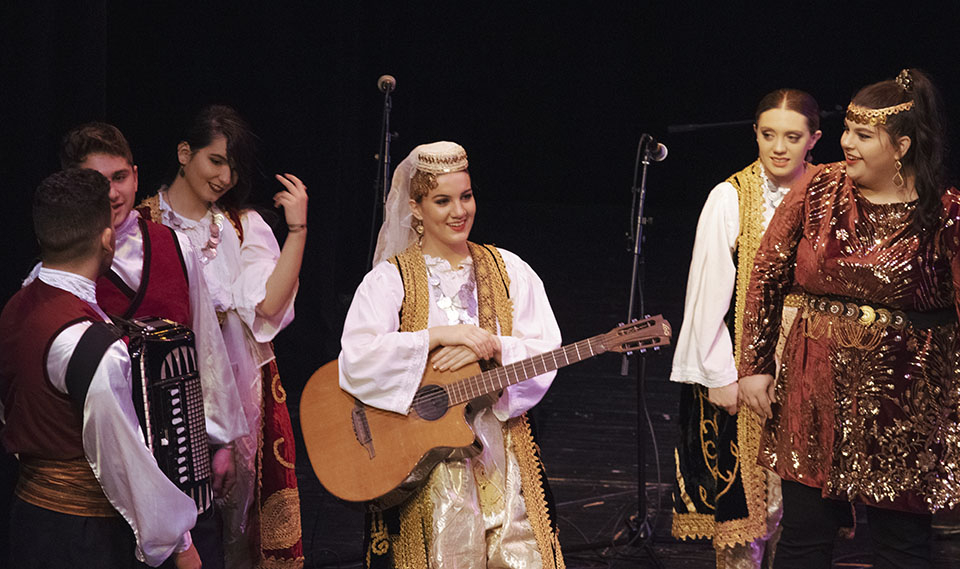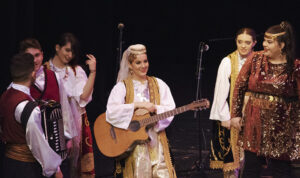
Griffin Sendek | Photo Editor
03/12/2020

The life of a Tamburitzan is one that is always on the move. Whether it be gracefully gliding across the stage, traveling around the country or racing through the studio to find the right color socks, a Tamburitzan never stops.
The Tamburtizans gave a brief 45 minute performance on Feb. 29, for the students at Pittsburgh Creative and Performing Arts School (CAPA). Before they could take the stage, everything needed to be prepared and ready to go back at the Tamburitzan headquarters on Bluff Street.
Performance prep is at the Tamburitzan headquarters, and it’s an organized mess of performers packing up and moving an assortment of musical instruments, piecing together layers of elaborate outfits and chains of girls braiding one another’s hair.
For the most part, it all takes place in a single narrow hallway adorned floor to ceiling with dozens of black and white headshots of Tamburitzans from eras gone by.
The Tamburitzans have a deeply rooted history in the city of Pittsburgh and Duquesne University. This traditional Eastern European song and dance group got its start in the city back in 1937 and is still thriving more than 80 years later.
The group joined Duquesne University shortly after, and at the time would offer full scholarships to all of its members. For financial reasons, the university parted ways with the Tamburitzans in 2016, transforming the troupe into an independent non-profit.
Though the Tamburitzans are officially separate from the university, 22 out of its 29 members are students currently enrolled at Duquesne.
This performance for Pittsburgh CAPA was a number depicting traditional Serbian songs and dances. This showcase, however, was just one piece of what the Tamburitizans have to offer in their 2019-2020 season: Symbols-Expressions of Culture.
The showing for the CAPA students was significantly toned down from the Tamburitzans usual affair.
“This is literally nothing compared to what we normally have, you just see wires and cables going all across the floor, lights lots of lights and sometimes you’ll see costumes just all over,” Stevan Pastar, a first-year music education student, said.
The entirety of the two-hour show is learned in less than a single month during Tamburitzan summer camp.
“It takes us … about a day to learn the set, and we just pound through it we just keep going and going,” Tamburitzan dancer and third-year biochemistry major Alex Hrisenko said.
All the members learn the set as a group, blocking exactly where they’re supposed to be before adding style into the mix.
“For male dancers and female dancers I would say that the work is entirely the same; it’s all style, it’s very stylistic and the costumes are different,” Hrisenko said.
Learning a wide variety of intense songs dances and from all across Europe is no easy feat but members of the Tamburitzans describe in an incredibly casual manner.
“Stylistically and stepwise to separate the men from the women and we each have some really hard sessions, and we’ll get that style down and really what we’re supposed to be doing. And then we go down to the wardrobe and they put different costumes on us,” Hrisenko said.
The full performance includes numbers from eight different cultures (Croatian, Georgian, Russian, Nordic, Serbian, Polish, Celtic and Bulgarian) each with their own unique costumes and performing style. The typical show utilizes far more technical elements — colorful lights, booming sound and a projector screen displaying the history and information about each country is typical.
“I personally prefer when it’s hectic; it gets you to stay on your feet. You never know what’s going to happen next,” Pastar said.
Though that Saturday afternoon performance was stripped down, that did not mean the frenetic nature of the Tamburitzans had but all gone away.
“We’re used to having everybody at the show with us, we have probably four or five people missing today so we have to reblock all of the dances,” Karsyn Kuhn, a second year nursing student, said. “We have to like makeup for the people that are missing and figure out what we need to do differently.”
The warmup before a performance is a tremendous cacophony unique only to the Tamburitizans. Nowhere else are will you find the discordant sound of tuning instruments both familiar and exotic joined by the constant clang of the metal pieces adorning the Serbian outfits and headdresses as dancers tap their feet on the hard wooden floor.
The presentation itself was nothing short of astounding. To say that every member of this group is immensely talented is a huge understatement.
The sound of the vocalists joining together in unison was hauntingly beautiful. It was clear that the immense amount of fun each member was having as the dancers raced around the stage.




